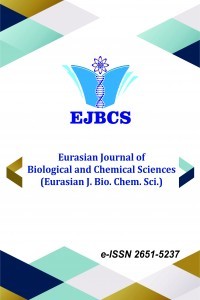Determination of Phytochemical Contents of Some Medicinal Aromatic Plants (Echinacea pallida, Melissa officinalis, Hypericum perforatum and Sideritis syriaca) Belonging to Antalya Region
Determination of Phytochemical Contents of Some Medicinal Aromatic Plants (Echinacea pallida, Melissa officinalis, Hypericum perforatum and Sideritis syriaca) Belonging to Antalya Region
Echinacea pallida, Melissa officinalis, Hypericum perforatum and Sideritis syriaca are valuable for its pharmaceutical, medicinal and agricultural properties. These plants were extracted with methanol/chloform (1:1) solvent, filtered, and solvents were removed by rotary evaporator to get four separate extracts. Quantifications of chemical constituents of extracts were determined by TOF-LC/MS and GC-MS. The main compounds of extracts for E. pallida were 4-Hydroxybenzoic acid Caffeic acid, for M. officinalis were Eupatorin and Diosmin, for S. syriaca Chlorogenic acid and Fumaric acid, for H. perforatum Quercetin-3-β-D-glucoside and Morin. The fatty acid contents of E. pallida is Palmitic acid composition (30.07%), of M. officinalis is Octadecatrienoic acid (43.39%), H. perforatum is Octadecatrienoic acid (31.37%) and of S .syriaca is Linoleic acid (34.89%).
Keywords:
Echinacea pallida, Melissa officinalis, Hypericum perforatum and Sideritis syriaca, HPLC-TOF/MS,
___
- Androutsopoulos V, Arroo R, Hall J, Surichan S, Potter G 2008. Antiproliferative and cytostatic effects of the natural product eupatorin on MDA-MB-468 human breast cancer cells due to CYP1-mediated metabolism. Breast Cancer Res, 10(3): R394
- Baykan EŞ, 2011. “Melissa officinalis L.” Tedavide Kullanılan Bitkiler FFD Monografları, Demirezer Ö, Ersöz T, Saraçoğlu Đ, Şener B (Eds.), 2. Baskı, MN Medical & Nobel Tıp Kitabevi, Ankara, 383- 90.
- Baytop T. 1999. Türkiye'de Bitkiler ile Tedavi (Geçmiste ve Bugün) İlaveli İkinci Baskı. Nobel Tıp Kitabevleri, Istanbul.
- Curtis J, Lersten N 1990. Internal secretory structures in Hypericum (Clusiaceae): H. perforatum L. and H. balearicum L. New Phytologist 114(4): 571-580.
- Davis P, Mill R, Tan K 1988. Astragalus L. Flora of Turkey and the East Aegean islands. 114-124.
- Davis PH 1965. Flora of Turkey. Flora of Turkey.
- De Smet P, Nolen WA 1996. St John's wort as an antidepressant. BMJ: British Medical Journal 313(7052): 241.
- Güner A, Özhatay N, Ekim T, Başer K 2000. Flora of Turkey and the east Aegean islands, Vol. 11. Second Supplement, Edinburgh.
- Kültür Ş 2007. Medicinal plants used in Kırklareli province (Turkey). Journal of ethnopharmacology, 111(2): 341-364.
- Linde K, Ramirez G, Mulrow CD, Pauls A, Weidenhammer W, Melchart D 1996. St John's wort for depression an overview and meta analysis of randomised clinical trials. Bmj 313(7052): 253-258.
- Nagao T, Abe F, Kinjo J, Okabe H 2002. Antiproliferative constituents in plants 10. Flavones from the leaves of Lantana montevidensis Briq. and consideration of structure-activity relationship. Biological and Pharmaceutical Bulletin 25: 875-879.
- Özyurt MS 1992. Ekonomik botanik. Erciyes Üniversitesi Yayınları (47).
- Prica F, Rotar I, Sıma NF 1998. The influence of the phenological phase on the fodder quality of the Festuca rubra and Agrostis capillaries species. Notulae Botanicae Horti Agrobotanici Cluj-Napoca 28(1): 21-26.
- Schinella GR, Giner RM, Recio MC, Mordujovich P, Rios JL, Manez S 1998. Anti-inflammatory effects of south American Tanacetum vulgare. Journal of Pharmaceutical Pharmacology 50: 1069-1074.
- Sina İ 2000. El Kanun Fi’t Tıbb, ikinci kitap. Türkçeye çeviren: Esin KAHYA) Atatürk Kültür Merkezi Başkanlığı Yayınları (234).
- Şaşkara C, Hürkul MM, Güvenç A 2010. Aktarlarda Satılan Melissa Offıcinalis L.(Oğulotu, Melisa) Üzerinde Morfolojik ve Anatomik Çalışmalar. Ankara Ecz. Fak. Dergisi 39(2): 123-143.
- Tezuka Y, Stampoulis P, Banskota AH, Awale S, Tran KQ, Saiki I, Kadota S 2000. Constituents of the Vietnamese medicinal plant Orthosiphon stamineus. Chemical and Pharmaceutical Bulletin 48: 1711-1719.
- Uzun E, Sarıyar G, Adsersen A, Karakoç B, Ötük G, Oktayoğlu E, Pırıldar S 2004. Traditional medicine in Sakarya province (Turkey) and antimicrobial activities of selected species. Journal of Ethnopharmacology 95: 287-296.
- Yayın Aralığı: Yılda 2 Sayı
- Başlangıç: 2018
- Yayıncı: Muhammet DOĞAN
Sayıdaki Diğer Makaleler
Ali Rıza TÜFEKÇİ, Serkan KÜÇÜK, Fatih GÜL, İbrahim DEMİRTAŞ
Cu katkılı biyocam ve Cu nanoparçacıklı Sr katkılı biyocamdan 3D kompozit yapı iskelesi üretimi
Ayşe ÖZYUĞURAN-ARİFOĞLU, Melek EROL TAYGUN, Sadriye KÜÇÜKBAYRAK
Betül CAN, Semih ÖZ, Ahmet MUSMUL, Tuğba ERKMEN, Ezgi YAVER, Meltem ERDAŞ, Özkan ALATAŞ
Aykut TOPDEMİR, Nazmi GÜR, Zümre DEMİR
Melek EROL TAYGUN, Gül HATİNOĞLU, Aybüge Pelin ÖZTÜRK, Nuray YERLİ, Sadriye KÜÇÜKBAYRAK
Melissa officinalis L. kallus kültürlerinin antoksidan özellikleri
